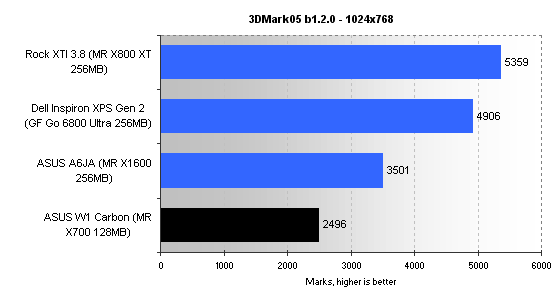Final Thoughts, HEXUS.awards & HEXUS.right2reply

Now superceded by the better-looking 3DMark06, 3DMark05 is still a useful tool in evaluating relative DirectX graphics performance. The ATI Mobility Radeon X700 128MB begins to show its generation-old age. The A6JA's MR X1600 256MB card is almost 50% faster, and it carries ATI's excellent Avivo technology as standard. Running the same test at the W1 Carbon's native 1680x1050 resolution returned a result of just 1,483 marks.

Far Cry performance is relatively good at 1024x768. Upping the resolution to 1680x1050, and thereby making the benchmark GPU-bound, returned an average framerate of 22.5FPS, making Far Cry juddery and generally unplayable, and suggesting that playing modern games at the WSXGA setting probably won't be possible with titles set to high-quality mode.
To further test this assertion, we also ran our custom Quake 4 (OpenGL) demo in high-quality mode. 1024x768 resolution returned an average framerate of 32FPS, and at 1680x1050 an average of just 19FPS. The ATI Mobility Radeon X700 128MB, then, is fine for older titles but don't expect F.E.A.R, for instance, to run smoothly at WSXGA. In view of this, and if you're a gamer, perhaps opting for the lower-resolution WXGA (1280x800) will be a better idea.
Final thoughts
There's no denying that the ASUSTek W1 Carbon is a beautifully constructed laptop with pleasing aesthetics from any angle. The carbon lid and brushed aluminium chassis make it one of the best-looking notebooks around. ASUS kits out this model with an integrated digital TV-tuner/FM card, an excellent LCD and generous bundle.
Performance-wise, the W1 Carbon's Pentium M 750 CPU makes short work of most applications, and if we'd been reviewing it before the introduction of Intel's Napa platform, as showcased by the ASUS A6JA model, we'd be impressed with the 'Carbon's performance. However, with a similarly priced Napa-powered notebook from ASUS featuring a better CPU, a faster hard drive, better graphics card and more system RAM (albeit without an integrated TV-Tuner), overall performance is comparatively weak at the £1,499 that ASUS is pitching the W1 Carbon at. Battery life, too, is on a par with the A6JA, with a full charge lasting less than 3 hours with simple web browsing and emailing.
The ASUSTek W1 Carbon will win a number of design awards, but, and it's a big but, the underlying technology and specification doesn't merit an outlay of £1,500. At the time of writing, you could purchase a W1 (sans carbon lid and not much else), outfitted with a faster Pentium M 760 CPU and 100GB 5,400RPM hard drive, for over a £100 less than the W1 Carbon's retail price. You could also opt for a better-performing Centrino Duo model (A6JA) for the same price, as well.
Are looks, along with marginally inferior performance, worth a 10% price premium? That depends on how much you value form over performance. As striking as the W1 Carbon is, it's a little too expensive to be recommended outright.














